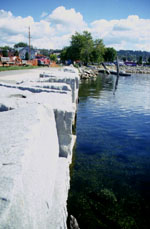



Perkins Pier
by Doug Porter
Perkins Pier is located at the site of the old steamboat dock at Maple and Battery, where Curtis Holgate first built a dock in 1810. The earliest traffic was with sailing ships, though steam-powered freighters eventually came to dominate due to their greater speed and capacity. The pier property passed from Holgate to Henry Mayo in 1818. Five years later Timothy Follett, who was to play so important a role in the development of Battery Street (named Water Street in 1830), became Mayo's partner. Canal and stagecoach traffic was directed here by 1823, and the wharf was at the center of one of the busiest commercial areas in Burlington. In 1826 the U.S. government placed a lighthouse on Juniper Island to facilitate traffic in the bay. Shipping created new markets for products grown or manufactured in Vermont, and Burlington became the major outlet of the region. The wharf became the steamboat landing and handled freight and passenger traffic. Warehouses and facilities for the transfer of shipped goods from one form of conveyance to another became the commerce centers of the developing lakefront. The breakwater was constructed in 1837 and a light was constructed on it by 1842. Development at the corner of Maple and Battery was related largely to the shipping business conducted from this dock. The shape and paving of the pier has changed over time, but it is possible that archeological evidence remains below water level.